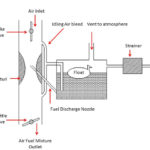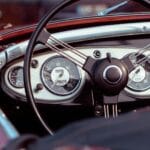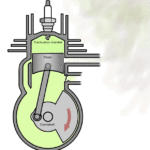When you look around you, you will find so many vehicles running whether it is running on roads, on water or in the air. They all have engines to run on roads, float on water and fly in the air. Now Confusion hits in our mind about which types of engine they are using to work. Do they have the same engine types or have different engines to work?
In this article, we will learn about different types of engines. The classification of the engines depends upon the types of fuel used, the cycle of operation, the number of strokes, the type of ignition, the number of cylinders, arrangement of cylinders, valve arrangement, types of cooling etc. these engines are used in different areas such as in automotive industries, aircraft industries, marine industries, etc. according to their suitability they are used in different areas. So let’s discuss different engine types one by one.
In joining the automotive industry, you must have extensive knowledge about the engine and their types. Here we will discuss each engine type in brief. If you want an in-depth engine guide then you can watch youtube videos or you can buy an online automotive basic course in which you will get a deep knowledge about how an engine works in a vehicle.
Here are some online courses that you can join
Types of Engine
Basically, engines are of two types, and these are
- External Combustion Engines: Combustion of fuel takes place outside the engines.
- Internal Combustion Engines: Combustion of fuel takes place inside the engines.

1. External Combustion Engine:
In an external combustion engine, the combustion of fuel takes place outside the engine. And mostly the fuel used is coal wood etc. Example: Steam engines
2. Internal Combustion Engine:
In an internal combustion engine, the combustion of fuel takes place inside the engine. Two-stroke and four-stroke petrol and diesel engine are examples of internal combustion engines.
There are different types of internal combustion (I.C.) engines and their classification depends upon various basis.
The I.C. engines are classified on the following basis:
- Types of Design: Rotary engine, reciprocating engines
- Types of fuel used: Petrol engines, diesel engines, gas engines.
- The cycle of Operation: Otto cycle engine, Diesel cycle, Dual cycle engine or semi-diesel cycle engine
- Number of Strokes: Two-stroke engine, four-stroke engine
- Types of ignition: Spark ignition engine (SI engine), compressed ignition engine (CI engine)
- Number of Cylinders: Single cylinder, Double Cylinder, Multi cylinder ( 3, 4, 6, 8, 12, 16 etc)
- Arrangement of Cylinders: Vertical, horizontal, radial, V-type, W-type, opposed cylinder.
- Valve Arrangement: L-head, I-head, F-head, T- head engine
- Types of Cooling: Air cooled, water cooled
You can also check toolsbible to get more information about the engine.
Now lets discuss each engine types in details:
1. Types of Design
On the basis of design, the engines are of two types and these are:
1. Reciprocating Enignes
In a reciprocating engine, there is a piston and cylinder, and the piston does reciprocating (To and Fro) motion within the cylinder. Due to the reciprocating motion of the piston, it is called the reciprocating engine. 2 stroke and four-stroke engines are common examples of the reciprocating engines.
2. Rotary Engines
In the rotary engine, the rotor does a rotary motion to produce power. There is no reciprocating motion. A rotor is present in the chamber which does rotary motion inside a chamber. Wankel rotary engine, and turbine engines are the rotary types of engine.
2. Types of Fuel Used
On the basis of types of fuel used, the engine is classified as a petrol engine, diesel engine and gas engine. You can also visit toolsinstitute to know more about this.
(i). Petrol Engine:
When pertol is used as fuel to run an internal combustion engine, it is called as petrol engine. Petrol engine have spark plug in order to poduce the spark for the combustion of air-fuel mixture. The petrol engines produces less power as compared with the diesel engine. Petrol engines may be two stroke and four stroke engines.
(ii). Diesel Engine:
The engine which uses diesel for its working is called a diesel engine. These engine are also called as compression ignition engine as heat of the compressed air us used to burn the diesel fuel. It produces more power then petrol engines.
(iii). Gas Engine:
An engine using gas fuel for working is called a gas engine. Most commonly CNC ( Compressed Natural Gas) is used as gas fuel to run the engine of the vehicles. CNG is cheapter than petrol and diesel fuels and better mileage.
3. Cycle of Operation
On the basis of the cycle of operation, the engine types are:
(i). Otto Cycle Engine:
This type of engine works on Otto cycle. Otto cycle is given by Dr. Nikolaus August Otto and on this cycle petrol engine works. All modern petrol engine works on Otto cycle. Otto cycle has four process : two isentropic (reversible adiabatic) process and two isochoric (constant volume) Processes.
(ii). Diesel Cycle Engine:
The engine working on diesel cycle is called a diesel cycle engine. Rudolph Diesel invented the diesel cycle in the year 1893. All engines that uses diesel as fuel works on Diesel cycle. Engine working on this cycle has higher compression ration, high thermal efficiency as compared with Otto cycle
(iii). Dual Cycle Engine or Semi-diesel Cycle Engine:
The engine that works on both diesel, as well as Otto cycle, is called dual cycle engine or semi-diesel cycle engine.
4. Number of Strokes
On the basis of the number of strokes, the types of engines are:
(i). Four Stroke Engine:
It is an engine in which the piston moves four times i.e.2 upward (from BDC to TDC) and 2 downward (from TDC to BDC) movements in one cycle of the power stroke is called four-stroke engines. The 4 strokes of this engine are
- Suction stroke: Suction of fir fuel mixture in (petrol engine) and suction of air in (Diesel engine)
- Compression stroke: Compression of air fuel mixture in petrol engine and comression of air in Diesel enignes.
- Power Stroke: Combustion of air-fuel mixture in petrol engine by spark plug and combustio of fuel in diesel engines by heat of the compressed air.
- Exhaust Stroke: Exit of the burnt gases in both petrol and diesel engines takes place.
(ii). Two Stroke Engine:
The engine in which the piston does two times motion i.e. one from TDC to BDC and the other from BDC to TDC to produce a power stroke is called two-stroke engine. In two stroke engines, all the four process of suction, compression, power and exhaust takes place it two stroke of the piston.
5. Type of Ignition
On the basis of ignition, the engines are classified as:
(i). Spark Ignition Engine (SI Engine):
In spark ignition engine there is a spark plug which is fitted at the engine head. The spark plug produces spark after the compression of the fuel and ignites the air fuel mixture for the combustion. The petrol engines are spark ignition engine.
(ii). Compression Ignition Engine (CI Engine):
In Compression ignition engine there is no spark plug at the cylinder head. The fuel is ignited by the heat of the compressed air. The diesel engines are compression ignition engine.
Also Read:
- How Free Piston Engine Works?
- Valve Timing Diagram of Two Stroke and Four Stroke Engine
- How DTSi Engine Works – Explained?
6. Number of Cylinders
On the basis of the number of cylinders present in the engine, the types of engine are:

(i). Single cylinder engine: An engine which consists of single cylinder is called single cylinder engine. Generally the single cylinder engines are used in motorcycles, scooter, etc.
(ii). Double cylinder engine: The engine which consists of two cylinders is called double cylinder engine.
(iii). Multi-cylinder engine: An engine which consists of more than two cylinders is called multi cylinder engine. The multi-cylinder engine may have three, four, six, eight, twelve and sixteen cylinder.
7. Arrangement of Cylinders

On the basis of arrangement of cylinders the engines classification is:
(i). Vertical engine: in vertical engines, the cylinders are arranged in vertical position as shown in the diagram.
(ii). Horizontal engine: In horizontal engines, the cylinders are placed horizontal position as shown in the diagram given below.
(iii). Radial engine: The radial engine is reciprocating type internal combustion engine configuration in which the cylinders radiate outward from a central crankcase like the spokes of a wheel. When it is viewed from the front, it resembles a stylized star and is called a ‘star’ engine. Before the gas turbine engine is not become predominant, it is commonly used for aircraft engines.
(iv). V-engine: In v types of engine, the cylinders are placed in two banks having some angle between them. The angle between the two banks is keep as small as possible to prevent vibration and balancing problem.
(v). W type engine: In w type engines, the cylinders are arranged in three rows such that it forms W type arrangement. W type engine is made when 12 cylinder and 16 cylinder engines are produced.
(vi). Opposed cylinder engine: In opposed cylinder engine, the cylinders are place opposite to each other. The piston and the connecting rod show identical movement. It is runs smoothly and has more balancing. The size of the opposed cylinder engine increase because of its arrangement.
8. Valve Arrangement
According to the valve arrangement of the inlet and exhaust valve in various positions in the cylinder head or block, the automobile engines are classified into four categories. These arrangements are named as ‘L’, ‘I’, ‘F’ and ‘T’. It is easy to remember the word ‘LIFT’ to recall the four valve arrangement.

(i). L-head engine: In these types of engine, the inlet and exhaust valves are arranged side by side and operated by a single camshaft. The cylinder and combustion chamber forms and inverted L.
(ii). I-head engine: In I-head engines, the inlet and exhaust valves are located in the cylinder head. A single valve actuates all the valves. These types of engine are mostly used in automobiles.
(iii). F-head engine: It is a combination of I-head and F-head engines. In this, one valve usually inlet valve is in the head and the exhaust valve lies in the cylinder block. Both the sets of valve are operated by the single camshaft.
(iv). T-head engine: In T-head engines, the inlet valve located at one side and the exhaust valve on other side of the cylinder. Here two camshafts are required to operate, one for the inlet valve and other one is for the exhaust valve.
Also Read:
- Types of Gearbox – Complete Explanation
- Torque Converter Working, Principle, Main Parts and Application.
- Types of Supercharger in Automobile
9. Types of cooling
On the basis of types of cooling, the engines are classified as:
(i). Air cooled engines:
In these engines, the air is used to cool the engines. In air cooled engines the cylinder barrels are separated and metal fins are used which provides radiating surface area that increase cooling. The air cooled engines are generally used in motorcycles and scooters.
(ii). Water cooled engines:
In water cooled engines, the water is used for the cooling of engine. Water cooled engines are used in cars, buses, trucks and other four wheeled vehicles, heavy duty motor vehicles. An anti-freezing agent is added in the water to prevent it from freezing during cold weather. Every water cooled engines has radiator for the cooling of hot water from the engine.
Besides the above types of engines, the internal combustion engine is also classified on the basis of the following.
1. Speed:
On the basis of speed, the types of engines are:
(i). Low speed engine
(ii). Medium speed engine
(iii). High speed engine
2. Method of Fuel Injection
On the basis of the method of fuel injection, the engines are classified as:
(i). Carburettor engine
(ii). Air injection engine
(iii). Airless or solid injection engine
3. Method of Governing
(i). Hit and miss governed engine: It is an engine type in which the entry of the fuel is controlled by the governor. It controls the speed of the engine by cutting off the ignition and fuel supply of the engine at very high speed.
(ii). Qualitatively governed engine
(iii). Quantitatively governed engine
4. Application
(i). Stationary engine: Stationary engine is an engine in which its framework does not move. It is used to drive immobile equipment like pump, generator, mill or factory machinery etc.
(ii). Automotive engine: These are the types of engines which are used in automobile industries. For example: petrol engine, diesel engine, gas engine are internal combustion engines falls in the category of automotive engine.
(iii). Locomotive engine: The engines which are used in trains are called locomotive engines.
(iv). Marine engine: The engines which are used in marines for boat or ship propulsion is called marine engine.
(v). Aircraft engine: Types of engine which are used in aircraft is called aircraft engine. Radial and gas turbine engines are used in aircraft propulsion.
Conclusion
Here we have discussed the different types of engines, we have studied mostly internal combustion engines and their working, if you found this piece of information useful and valuable then don’t forget to like and share it.









Hello … Sir, my name is Jayanti Hadiyal. The information given on this web site is absolutely good and I have learned a lot. Thanks giving….
HELLO! sir thanks i have learned
a lot my name is Kenneth kpughile.
Hello,am Faith Vusha…i have really learnt alot on this web,now am able to distinguish the different types of engines…thanks